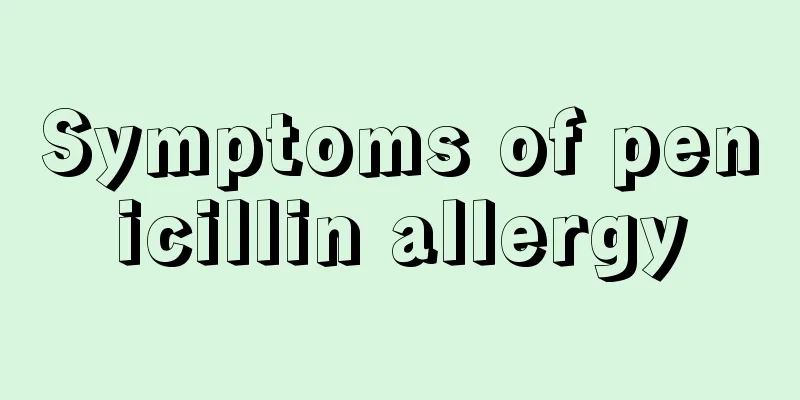Symptoms of penicillin allergy

|
Medicines are commonly used by people. They are very helpful in treating diseases. Different medicines have different effects when used. When choosing medicines, you also need to have a good understanding of them so that no abnormal phenomena will occur when using them, causing damage to your health. So what are the symptoms of penicillin allergy? Many people don’t understand this.
Many people are not very clear about the symptoms of penicillin allergy, so when choosing penicillin, they must also have a good understanding of how to use it, so that they can use it with confidence without too much threat to themselves. Symptoms of penicillin allergy: Anaphylactic shock is the most serious and common reaction to penicillin. It can occur throughout the entire process of penicillin use. It is more common in adults aged 20 to 40, more common in women than in men, less common in the elderly and children, and rare in infants. Various dosage forms and routes of administration of penicillin can cause anaphylactic shock, and the occurrence of the reaction is unrelated to the dose. Anaphylactic shock usually occurs extremely quickly, most occurring within 15 minutes after injection, even before the needle is removed. In a few cases, the symptoms may occur several hours after administration or during continuous administration. The general clinical manifestations can be divided into the following parts: 1. Symptoms of respiratory obstruction: chest tightness and shortness of breath, laryngeal obstruction, dyspnea, suffocation, cyanosis, etc., caused by laryngeal edema, bronchial spasm edema and pulmonary edema. 2. Symptoms of circulatory failure: pale complexion, chills, cold sweat, cold limbs, irritability, weak pulse, low blood pressure, etc. 3. Symptoms of the central nervous system: loss of consciousness, coma, convulsions, incontinence, etc., may be caused by brain hypoxia. Some patients may develop sequelae such as aphasia, hemiplegia, and Parkinson's syndrome. 4. Allergic skin reactions, such as itching, urticaria or other rashes. 5. Gastrointestinal symptoms: abdominal pain, diarrhea, nausea and vomiting, etc. Through the above introduction, we have a good understanding of the symptoms of penicillin allergy. When these situations occur, timely treatment must be received, which will be of great help in stabilizing the patient's disease. However, when using penicillin to treat the disease. You should also be rational in your dietary choices and reduce the choice of spicy and greasy foods. |
Recommend
How many methods are there to remove acne scars?
I believe everyone knows that after acne appears,...
Is there any difference between monkey leg fern and bracken?
In modern life, people are increasingly fond of e...
How to cure loss of voice immediately
Loss of voice in the throat is very common in dai...
What are the fastest ways to get rid of acne?
Removing acne is an issue that many people hope t...
Pimples behind the ears
Children often guess riddles: a gourd head with s...
How long after physical cooling should I measure body temperature
Many people think of physical cooling when they h...
The main cause of melanoma
Melanoma is a very common disease in life, but mo...
What are the causes of ovarian cancer?
The cause of ovarian cancer is still unclear, but...
How to increase height for junior high school students
We all know that junior high school students are ...
Is the alpha-fetoprotein level high in early small liver cancer?
Small hepatocellular carcinoma generally refers t...
2 delicious dishes for treating liver cancer jaundice
Mid- to late-stage liver cancer is a more serious...
What are the diagnosis methods for liver cancer? 7 differential diagnosis methods for liver cancer
Liver cancer is one of the most common malignant ...
How long can you live with nasopharyngeal carcinoma bone metastasis
How long can you live with nasopharyngeal carcino...
Can salt water really reduce inflammation?
Salt is a common seasoning in our lives, and it i...
What is the gross morphological classification of liver cancer?
Everyone has heard of liver cancer, right? But ho...









